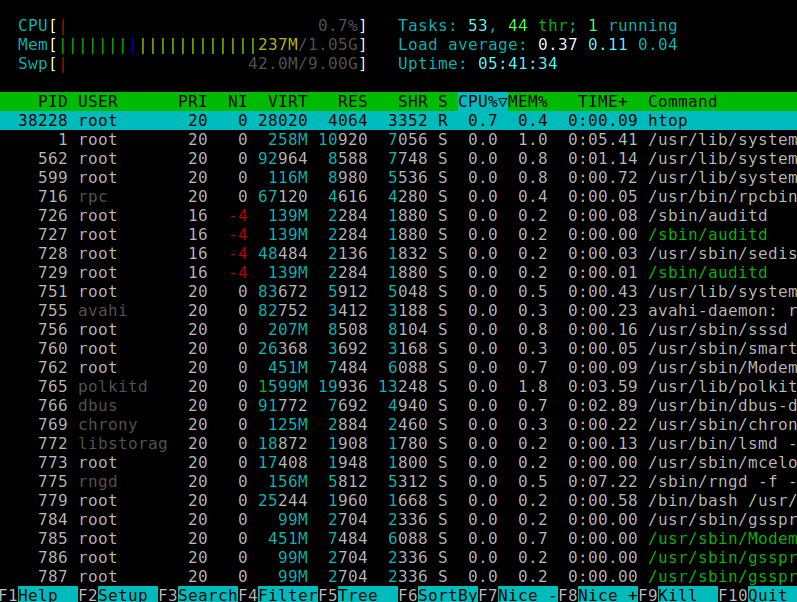In the world of Linux system administration and DevOps, stability and performance are paramount. A server that is slow, unresponsive, or down can have catastrophic effects on business operations, user experience, and revenue. This is where system monitoring becomes not just a best practice, but an essential discipline. Effective monitoring provides the visibility needed to proactively identify issues, optimize performance, and ensure reliability. It transforms system management from a reactive, fire-fighting exercise into a strategic, data-driven process.
This article will guide you through the multifaceted world of Linux system monitoring. We’ll start with the fundamental command-line tools that every administrator should know, progress to powerful scripting techniques for automation, and finally, explore how to build a modern, scalable monitoring stack with industry-standard tools like Prometheus and Grafana. Whether you’re managing a single Linux server or a fleet of containers in the cloud, these principles and practices will empower you to turn system chaos into operational clarity.
The Foundations: Core Metrics and Command-Line Tools
Before diving into complex monitoring stacks, it’s crucial to understand what to monitor and how to check it manually. The core pillars of system health, often called the “four golden signals” in a broader context, can be simplified for a single machine into CPU, Memory, Disk I/O, and Network activity. Mastering the classic Linux utilities for observing these metrics is a fundamental skill for any Linux professional, from those working with Debian Linux and Ubuntu to enterprise environments using Red Hat Linux or CentOS.
Key Metrics to Watch
- CPU Utilization: Measures how busy the processor is. High utilization can indicate a performance bottleneck. Key things to look for are user time, system time, and idle time.
- Memory Usage: Tracks how much RAM is being used. It’s important to distinguish between used memory, free memory, and memory used for buffers/cache. Running out of memory can lead to “swapping” to disk, which severely degrades performance.
- Disk I/O and Space: Monitors the read/write activity of your storage devices and the amount of free space available. High I/O wait times can slow down applications, and running out of disk space can bring a system to a halt.
- Network Traffic: Observes the amount of data being sent and received over network interfaces. Spikes in traffic or high error rates can indicate network issues or security events.
Essential Linux Commands
The Linux terminal is your first port of call for a quick health check. Tools like top, htop, free, df, and iostat provide a real-time snapshot of your system. While powerful for immediate diagnostics, their output is ephemeral. To capture this data for later analysis, we can use Bash scripting.
The following script provides a simple, automated way to generate a daily system health report, combining several commands into one cohesive output. This is a great example of basic Linux automation.
#!/bin/bash
# A simple Bash script to generate a daily system health report.
# Get the current date for the report file
REPORT_DATE=$(date +"%Y-%m-%d")
REPORT_FILE="/var/log/system-health-report-$REPORT_DATE.txt"
echo "==================================================" > "$REPORT_FILE"
echo "System Health Report for: $REPORT_DATE" >> "$REPORT_FILE"
echo "Hostname: $(hostname)" >> "$REPORT_FILE"
echo "==================================================" >> "$REPORT_FILE"
echo "" >> "$REPORT_FILE"
# Section 1: CPU Load Average
echo "--- CPU Load Average ---" >> "$REPORT_FILE"
uptime >> "$REPORT_FILE"
echo "" >> "$REPORT_FILE"
# Section 2: Memory Usage
echo "--- Memory Usage (in MB) ---" >> "$REPORT_FILE"
free -m >> "$REPORT_FILE"
echo "" >> "$REPORT_FILE"
# Section 3: Disk Space Usage
echo "--- Filesystem Disk Space Usage ---" >> "$REPORT_FILE"
df -h >> "$REPORT_FILE"
echo "" >> "$REPORT_FILE"
# Section 4: Top 5 CPU Consuming Processes
echo "--- Top 5 CPU Consuming Processes ---" >> "$REPORT_FILE"
ps -eo pid,ppid,cmd,%mem,%cpu --sort=-%cpu | head -n 6 >> "$REPORT_FILE"
echo "" >> "$REPORT_FILE"
echo "Report generated at: $(date)" >> "$REPORT_FILE"
echo "Report saved to: $REPORT_FILE"
# You can schedule this script to run daily using cron.
# Example crontab entry to run at 2 AM every day:
# 0 2 * * * /path/to/your/script.shProgrammatic Monitoring with Python for Automation
While Bash scripting is excellent for simple reports, Python scripting offers more power, flexibility, and better data handling capabilities, making it a cornerstone of modern Python DevOps and system administration. For programmatic system monitoring, the psutil (process and system utilities) library is an indispensable tool. It provides a cross-platform API for retrieving information on running processes and system utilization (CPU, memory, disks, network, sensors) in Python.
Using psutil, we can create sophisticated scripts that collect metrics, process them, and send them to a logging service, a database, or an alerting system. This moves us from static reports to dynamic data collection.
Collecting Metrics with psutil
The following Python script demonstrates how to use psutil to gather key system metrics and format them as a JSON object. JSON is a machine-readable format, making it easy to send this data to other services for storage and analysis. This script is a foundational piece for building a custom monitoring agent.
#!/usr/bin/env python3
# A Python script to collect system metrics using psutil and output as JSON.
import psutil
import json
import platform
import datetime
def get_system_metrics():
"""
Gathers key system metrics and returns them as a dictionary.
"""
metrics = {
"timestamp": datetime.datetime.utcnow().isoformat() + "Z",
"hostname": platform.node(),
"cpu": {
"percent_per_cpu": psutil.cpu_percent(interval=1, percpu=True),
"percent_total": psutil.cpu_percent(interval=1, percpu=False),
"load_avg": [x / psutil.cpu_count() * 100 for x in psutil.getloadavg()]
},
"memory": {
"total_gb": psutil.virtual_memory().total / (1024**3),
"available_gb": psutil.virtual_memory().available / (1024**3),
"percent_used": psutil.virtual_memory().percent,
},
"disk": {
"total_gb": psutil.disk_usage('/').total / (1024**3),
"used_gb": psutil.disk_usage('/').used / (1024**3),
"free_gb": psutil.disk_usage('/').free / (1024**3),
"percent_used": psutil.disk_usage('/').percent
},
"network": {
"bytes_sent": psutil.net_io_counters().bytes_sent,
"bytes_recv": psutil.net_io_counters().bytes_recv
}
}
return metrics
if __name__ == "__main__":
system_metrics = get_system_metrics()
# Print the metrics as a nicely formatted JSON string
print(json.dumps(system_metrics, indent=4))
# In a real-world scenario, you would send this JSON data to a
# centralized monitoring system, time-series database, or logging platform.
# For example:
# import requests
# requests.post('https://your-monitoring-api.com/metrics', json=system_metrics)This script provides a structured, repeatable way to collect data. By running it periodically (e.g., via a systemd timer or cron job), you can start building a historical record of your system’s performance, which is essential for trend analysis and capacity planning.
Building a Modern Monitoring Stack: Prometheus and Grafana
While custom scripts are powerful, they require you to build the entire data storage, visualization, and alerting pipeline yourself. For a more robust and scalable solution, the open-source community has rallied around tools like Prometheus and Grafana. This combination has become the de facto standard for monitoring in Linux DevOps, especially in environments running containers with Docker or Kubernetes.
How Prometheus and Grafana Work Together
- Prometheus: An open-source monitoring and alerting toolkit. It operates on a “pull” model, where the Prometheus server periodically scrapes (fetches) metrics from configured endpoints, called “exporters.” For basic Linux server monitoring, you would run the
node_exporteron your target machines. Thenode_exporterexposes a vast array of hardware and OS metrics on an HTTP endpoint. - Grafana: An open-source platform for monitoring and observability that excels at visualization. Grafana connects to Prometheus (and many other data sources) to query the collected data and build beautiful, interactive dashboards. It turns raw time-series data into actionable insights.
Setting Up Prometheus to Scrape a Node Exporter








First, you need to download and run the node_exporter on the Linux server you want to monitor. Once it’s running (typically on port 9100), you configure your Prometheus server to scrape it. This is done in the Prometheus configuration file, prometheus.yml.
# prometheus.yml - Sample configuration file
global:
scrape_interval: 15s # How frequently to scrape targets by default
evaluation_interval: 15s # How frequently to evaluate rules
# A scrape configuration containing exactly one endpoint to scrape:
# Here it's the Node Exporter on a local machine.
scrape_configs:
# The job name is added as a label `job=<job_name>` to any timeseries scraped from this config.
- job_name: 'node_exporter_metrics'
# metrics_path defaults to '/metrics'
# scheme defaults to 'http'.
static_configs:
- targets: ['localhost:9100'] # Assumes node_exporter is running on the same machine
labels:
instance: 'web-server-01'
- targets: ['192.168.1.101:9100'] # An example of a remote server
labels:
instance: 'db-server-01'With this configuration, Prometheus will automatically start collecting hundreds of detailed metrics from your servers. You can then connect Grafana to your Prometheus server as a data source and import a pre-built dashboard (like Node Exporter Full, ID: 1860 on Grafana.com) or build your own to visualize CPU, memory, disk, and network performance over time.
Advanced Techniques and Best Practices
Effective system monitoring goes beyond just collecting and displaying data. It involves intelligent alerting, understanding context, and adopting best practices to avoid common pitfalls.
Intelligent Alerting with Alertmanager








Prometheus is paired with a component called Alertmanager to handle alerting. You define alerting rules in Prometheus that specify conditions to watch for (e.g., CPU utilization above 90% for 5 minutes). When a rule’s condition is met, Prometheus fires an alert to Alertmanager. Alertmanager then takes care of deduplicating, grouping, and routing these alerts to the correct notification channel, such as email, Slack, or PagerDuty.
Here is an example of a simple alerting rule defined in a Prometheus rules file.
# alert.rules.yml
groups:
- name: host_alerts
rules:
- alert: HighCpuLoad
expr: 100 - (avg by(instance) (rate(node_cpu_seconds_total{mode="idle"}[5m])) * 100) > 90
for: 10m
labels:
severity: warning
annotations:
summary: "High CPU load on instance {{ $labels.instance }}"
description: "CPU load is over 90% for the last 10 minutes on {{ $labels.instance }}."
- alert: HostOutOfMemory
expr: node_memory_MemAvailable_bytes / node_memory_MemTotal_bytes * 100 < 10
for: 5m
labels:
severity: critical
annotations:
summary: "Host out of memory on instance {{ $labels.instance }}"
description: "{{ $labels.instance }} has less than 10% memory available."
- alert: HostDiskAlmostFull
expr: (node_filesystem_avail_bytes{mountpoint="/"} / node_filesystem_size_bytes{mountpoint="/"}) * 100 < 10
for: 5m
labels:
severity: critical
annotations:
summary: "Host disk is almost full on instance {{ $labels.instance }}"
description: "The root filesystem on {{ $labels.instance }} has less than 10% space remaining."Best Practices for System Monitoring
- Establish Baselines: You can’t know what’s abnormal if you don’t know what’s normal. Collect data over time to establish a performance baseline for your systems during typical operation.
- Monitor Application-Specific Metrics: Don’t just monitor the system; monitor the applications running on it. Use application-specific exporters or custom instrumentation to track metrics like transaction times, error rates, and queue depths.
- Avoid Alert Fatigue: Don’t alert on every little spike. Use thresholds and `for` clauses (as shown in the example) to alert only on sustained problems. Alerts should be actionable; if an alert doesn’t require someone to do something, it’s just noise.
- Secure Your Monitoring Stack: Your monitoring data is sensitive. Ensure that access to Prometheus, Grafana, and exporter endpoints is properly secured, for example, by using a Linux firewall like
iptablesorufwto restrict access. - Use Configuration Management: Deploy and manage your monitoring agents (like `node_exporter`) and configurations using automation tools like Ansible. This ensures consistency and scalability across your entire infrastructure.
Conclusion: From Data to Insight
We’ve journeyed from the humble beginnings of single Linux commands to the sophisticated architecture of a modern monitoring stack. The key takeaway is that system monitoring is a layered discipline. The immediate feedback from tools like htop and iostat is invaluable for live debugging, while Python scripting with psutil unlocks powerful automation for custom data collection. Ultimately, for a comprehensive and scalable view of your infrastructure, adopting a centralized system like Prometheus and Grafana is essential.
Effective monitoring is the bedrock of reliable system administration and a proactive DevOps culture. By transforming raw data into visual dashboards and intelligent alerts, you gain the insight needed to not only fix problems but prevent them entirely. As your next step, consider exploring container monitoring with Kubernetes, integrating logging with your metrics, or using tools like Ansible to automate the deployment of your entire monitoring infrastructure.




